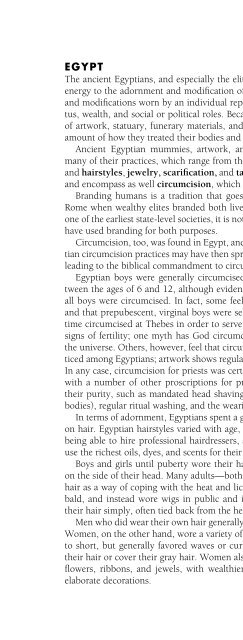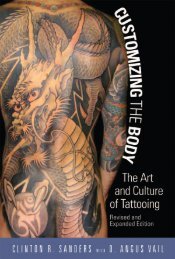Encylopedia of Body Adornment.pdf - Print My Tattoo
Encylopedia of Body Adornment.pdf - Print My Tattoo
Encylopedia of Body Adornment.pdf - Print My Tattoo
You also want an ePaper? Increase the reach of your titles
YUMPU automatically turns print PDFs into web optimized ePapers that Google loves.
EGYPT<br />
The ancient Egyptians, and especially the elites, devoted a great deal <strong>of</strong> time and<br />
energy to the adornment and modification <strong>of</strong> the body. The types <strong>of</strong> adornments<br />
and modifications worn by an individual represented a great deal about their status,<br />
wealth, and social or political roles. Because the Egyptians left such a wealth<br />
<strong>of</strong> artwork, statuary, funerary materials, and mummies, we know a tremendous<br />
amount <strong>of</strong> how they treated their bodies and what the standards <strong>of</strong> beauty were.<br />
Ancient Egyptian mummies, artwork, and artifacts provide information on<br />
many <strong>of</strong> their practices, which range from the decorative—makeup, henna, wigs<br />
and hairstyles, jewelry, scarification, and tattooing—to the punitive (branding)<br />
and encompass as well circumcision, which marks social status for boys.<br />
Branding humans is a tradition that goes back to at least ancient Egypt and<br />
Rome when wealthy elites branded both livestock and slaves with a hot iron. As<br />
one <strong>of</strong> the earliest state-level societies, it is not surprising that the Egyptians would<br />
have used branding for both purposes.<br />
Circumcision, too, was found in Egypt, and may have spread from Africa. Egyptian<br />
circumcision practices may have then spread to other nearby lands, eventually<br />
leading to the biblical commandment to circumcise.<br />
Egyptian boys were generally circumcised with sharpened copper blades between<br />
the ages <strong>of</strong> 6 and 12, although evidence from mummies indicates that not<br />
all boys were circumcised. In fact, some feel that only priests were circumcised,<br />
and that prepubescent, virginal boys were selected to be priests, and were at that<br />
time circumcised at Thebes in order to serve the gods. Circumcised penises were<br />
signs <strong>of</strong> fertility; one myth has God circumcising himself and his blood created<br />
the universe. Others, however, feel that circumcision was almost universally practiced<br />
among Egyptians; artwork shows regular men who were clearly circumcised.<br />
In any case, circumcision for priests was certainly mandatory, and was combined<br />
with a number <strong>of</strong> other proscriptions for priests that were enacted to maintain<br />
their purity, such as mandated head shaving (indeed, priests shaved their entire<br />
bodies), regular ritual washing, and the wearing <strong>of</strong> only linen clothing.<br />
In terms <strong>of</strong> adornment, Egyptians spent a great deal <strong>of</strong> time, energy, and money<br />
on hair. Egyptian hairstyles varied with age, gender, and social status, with elites<br />
being able to hire pr<strong>of</strong>essional hairdressers, afford the most expensive wigs, and<br />
use the richest oils, dyes, and scents for their hair.<br />
Boys and girls until puberty wore their hair shaved except for a side lock left<br />
on the side <strong>of</strong> their head. Many adults—both men and women—also shaved their<br />
hair as a way <strong>of</strong> coping with the heat and lice. However, adults did not go about<br />
bald, and instead wore wigs in public and in private. Slaves and servants wore<br />
their hair simply, <strong>of</strong>ten tied back from the head.<br />
Men who did wear their own hair generally wore it short, with the ears exposed.<br />
Women, on the other hand, wore a variety <strong>of</strong> hairstyles (and wig styles) from long<br />
to short, but generally favored waves or curls. Many women used henna to dye<br />
their hair or cover their gray hair. Women also decorated their hair and wigs with<br />
flowers, ribbons, and jewels, with wealthier women being able to afford more<br />
elaborate decorations.<br />
EGYPT 101



